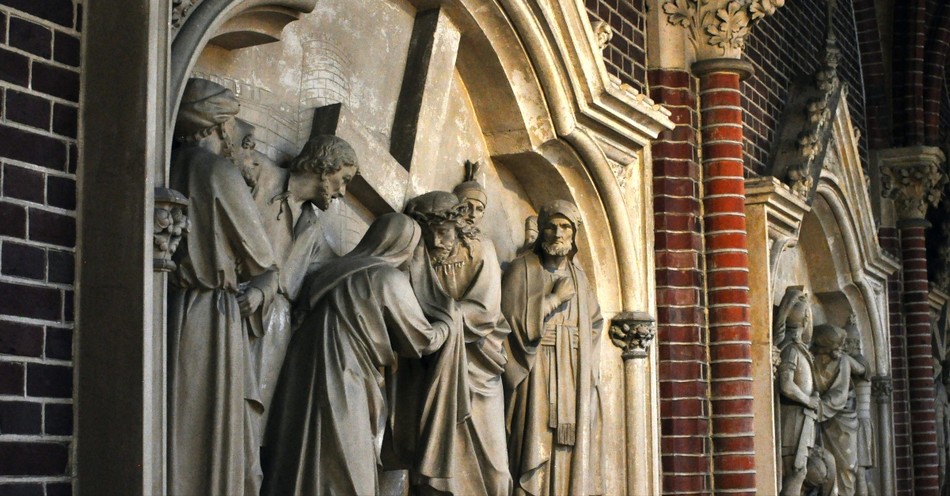For most believers in Western cultures, Christmas has become the major Christian holiday. This wasn’t the case for the majority of Christian history. Up until the 20th century, Easter was the primary holiday.
Christians celebrated Christmas, but the focus of the year centered around the death and resurrection of Jesus. Even within the Gospels, two mention the nativity and virgin birth. All four take time to detail the death and resurrection of Jesus. From the time of the early church, traditions of all types emerged to help followers of Jesus remember the Easter narrative and Jesus’ sacrifice for our salvation.
A major development was the stations of the cross, a series of important moments during the final hours of Jesus’ life to the crucifixion.
Why Did the Church Develop the Stations of the Cross?
The development of the Stations of the Cross, also known as the Way of the Cross or Via Crucis, stems from a desire within the Christian Church to commemorate and reflect upon the events leading up to the crucifixion. The Stations of the Cross represent a devotional practice that traces the journey of Jesus from his condemnation to his burial, typically consisting of fourteen stations or scenes. This practice has its roots in the early centuries of Christianity but became more formalized during the medieval period.
One of the earliest accounts of a form of the Stations of the Cross dates back to the fourth century when Saint Jerome, a prominent theologian, and scholar, described Christians visiting various sites in Jerusalem associated with Jesus’ passion and death. These pilgrimages allowed believers to walk in the footsteps of Jesus and reflect on the significance of each location.
However, it was not until the medieval period that the Stations of the Cross as we know them today began to take shape. Pilgrimages to the Holy Land became increasingly difficult due to political instability and the threat of Muslim conquest, prompting Christians to seek alternative ways to engage in devotional practices related to the passion of Christ.
The Franciscan Order played a significant role in popularizing the Stations of the Cross during the Middle Ages. Tradition holds that Saint Francis of Assisi, the founder of the Franciscans, visited the Holy Land in the early thirteenth century and was deeply moved by the sites associated with Jesus’ suffering and death. Upon returning to Italy, he sought to recreate the experience for those unable to make the journey to Jerusalem.
Saint Francis and his followers erected outdoor shrines or chapels featuring artwork depicting scenes from Jesus’ passion, allowing believers to meditate on each station and engage in prayer and reflection. Over time, the fourteen stations became standardized, representing key moments in Jesus' journey to Calvary, from his condemnation by Pontius Pilate to his burial in the tomb.
The development of the Stations of the Cross served several purposes within the Church. Firstly, it provided a tangible and immersive way for believers to enter into the story of the Passion, fostering a deeper understanding of his sacrifice and the significance of redemption. Secondly, it offered an opportunity for personal and communal reflection, inviting Christians to meditate on the profound love and mercy demonstrated through Christ’s suffering and death.
Additionally, expressing the Stations of the Cross in visual mediums became a way for the illiterate to engage in the story, as many in Europe and around the world couldn’t read. This had the extra benefit of using the arts and great artists in church worship.
What are the Stations of the Cross?
The Stations of the Cross typically begin with Jesus’ condemnation by Pontius Pilate and conclude with his burial in the tomb. Each station represents a specific moment in the Passion narrative.
The stations are often displayed along a path or route within churches, chapels, or outdoor settings, allowing worshippers to physically walk the journey of Jesus' suffering. As believers move from station to station, they engage in prayer, meditation, and contemplation, entering into the story of Jesus' Passion in a profound and personal way.
The fourteen traditional stations are as follows:
- Jesus is condemned to death (Matthew 27:22-23)
- Jesus takes up his cross (John 19:16-17)
- Jesus falls for the first time
- Jesus meets his mother, Mary (John 19:25-27)
- Simon of Cyrene helps Jesus carry the cross (Mark 15:21)
- Veronica wipes the face of Jesus
- Jesus falls for the second time
- Jesus meets the women of Jerusalem (Luke 23:27-31)
- Jesus falls for the third time
- Jesus is stripped of his garments (John 19:23-24)
- Jesus is nailed to the cross (John 19:18, 37)
- Jesus dies on the cross (Luke 23:44-46)
- Jesus is taken down from the cross (Luke 23:53)
- Jesus is laid in the tomb (Matthew 27:59-60)
Each station is accompanied by prayers, scripture readings, and reflections, guiding worshippers through the journey of Jesus' Passion and inviting them to contemplate the depth of his love and sacrifice.
How have Churches Used the Stations of the Cross?
Throughout history, the Church has employed the Stations of the Cross in various ways, adapting the practice to meet the needs of different cultures, communities, and spiritual traditions. These diverse uses reflect the enduring significance of the Stations as a devotional tool for Christians seeking to meditate on Jesus Christ's suffering and sacrifice.
In the early centuries of Christianity, pilgrims traveled to Jerusalem to visit sites associated with Jesus' Passion, such as the Via Dolorosa (Way of Sorrow) and the Church of the Holy Sepulchre. These pilgrimages allowed believers to walk in Jesus' footsteps and physically engage with the places where key events of his Passion occurred.
During the medieval period, the Franciscan Order played a significant role in popularizing the Stations of the Cross by erecting outdoor shrines or chapels featuring artistic representations of the stations. These stations were often placed along paths or routes in rural areas, allowing believers to engage in devotional practices in natural settings.
Within the context of liturgical worship, the Stations of the Cross are often incorporated into Lenten devotions and Holy Week services. Churches may hold special liturgies or processions where worshippers move from station to station, reflecting on the events of Jesus’ Passion through scripture readings, prayers, and hymns.
The Stations of the Cross have been compiled into devotional books or prayer guides, providing worshippers with a structured framework for meditating on Jesus’ suffering and sacrifice. These resources often include reflections, prayers, and scripture passages corresponding to each station, guiding believers through a contemplative journey.
Throughout history, artists have created countless representations of the Stations of the Cross in various forms, including paintings, sculptures, stained glass windows, and reliefs. These artistic depictions serve as visual aids for meditation and reflection, inviting worshippers to contemplate the depth of Jesus’ love and sacrifice.
In modern times, technology has enabled the dissemination of the Stations of the Cross through digital platforms and virtual experiences. Websites, apps, and virtual reality simulations allow believers to engage with the stations remotely, facilitating access to this devotional practice for individuals who may not have physical access to churches or outdoor shrines.
Overall, the diverse ways in which the Church has used the Stations of the Cross throughout history reflect its enduring relevance and adaptability as a devotional practice.
What Can We Learn from the Stations of the Cross Today?
The Stations of the Cross offer profound lessons for Christians today, guiding us on a transformative journey of faith, reflection, and discipleship. Instead of sitting and listening to a sermon or lecture, we get out of our seats and walk a path, engaging our bodies, hearts, minds, and souls holistically in reverence and meditation.
- Embrace Sacrificial Love. At each station, we witness the depth of Jesus’ sacrificial love as he willingly bears the weight of the cross and endures unimaginable suffering for the sake of humanity. This love challenges us to reflect on our own capacity for selflessness and to strive to love others with the same unconditional love demonstrated by Christ.
- Cultivate Compassion and Empathy. As we meditate on the Stations of the Cross, we experience Jesus’ suffering and empathize with his pain and anguish. This experience fosters a deeper sense of compassion for those who are marginalized, oppressed, or suffering in the world today, inspiring believers to actively seek justice, mercy, and reconciliation in their communities and beyond.
- Embrace Forgiveness and Reconciliation. Jesus’ journey to the cross is marked by moments of forgiveness and reconciliation, including his prayer for those who crucified him and his encounter with the repentant thief. The Stations of the Cross challenge us to embrace the transformative power of forgiveness, both in our personal lives and relationships with others, and to work towards reconciliation and healing in a broken and divided world.
- Trust in God's Providence. Throughout the Stations, Jesus demonstrates unwavering trust in God’s providence, even in the face of overwhelming suffering and uncertainty. This trust reminds us to place our hope and confidence in God’s faithfulness and to surrender our fears, doubts, and anxieties to the loving care of our Heavenly Father.
- Embrace the Cross in Daily Life. Jesus calls us to take up our cross daily, as disciples, the Stations of the Cross invite us to embrace the reality of the cross in our daily lives, recognizing that suffering and hardship are an inevitable part of the Christian journey. Just as Jesus embraced his cross with courage and humility, we are called to trust that God can bring beauty and redemption out of even the most difficult circumstances.
- Embrace the Arts in Expression of the Passion. The artistic and visual representations of the Stations of the Cross across history reveal how the church continued to integrate the creative arts in reverence and worship, to teach and to inspire. While our modern culture is far more literate, Christians should respect and remember to use visual mediums to express the central stories of the faith, especially in our modern digital age.
- Live in Hope of the Resurrection. Ultimately, the Stations of the Cross culminate in Jesus Christ's resurrection, demonstrating the victory of life over death and the promise of redemption and new life for all who believe. This message of hope and resurrection inspires us to live with confidence and assurance, knowing that even in the midst of suffering and adversity, God is at work, bringing about His purposes and fulfilling His promises.
As followers of Christ, we are called to walk in step with His Spirit and act out his love and grace to others around us. The Stations of the Cross engage our hearts, minds, and bodies to remind us to take up our cross for the sake of others, all in the hope of the coming resurrection in the Lord Jesus Christ.
Photo Credit: iStock/Getty Images Plus/debbiehelbing



.jpg)
